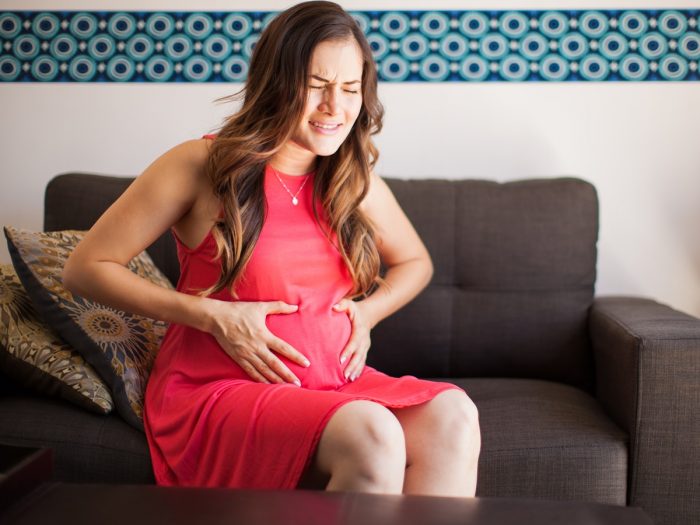There are many uncomfortable symptoms during pregnancy, and cramping in early pregnancy is something that many women have to deal with. Any changes in your body while you are carrying your child can be majorly stress-inducing, so it is best to understand why you get cramps, what they feel like, and ways to prevent and treat this common condition.
Are Cramps in Early Pregnancy Normal?
It is important to know that cramping in early pregnancy is completely normal and also fairly common. There is typically nothing to be concerned about, as your body is undergoing a massive amount of changes as a new life develops in your womb. As your body adjusts to accommodate your growing fetus, cramping is bound to happen to most women.
Even so, severe cramping can be debilitating and may be indicative of a problem with the pregnancy. Regardless of their severity, it is wise to mention them to your doctor, doula or midwife to ensure that everything is progressing normally. [1]

Cramping can also be a result of dehydration. Photo Credit: Shutterstock
Causes of Cramping in Early Pregnancy
There are quite a few causes of cramping in early pregnancy, including the bonding of the embryo to the uterus wall, the growth of the fetus, sexual intercourse, or the growth of new muscles and stretching of tendons/ligaments, among others.
Embryo Binding: When the embryo first binds to the wall of the uterus and begins to grow, it can cause mild cramping and some mild bleeding or spotting. This may be the first sign of pregnancy and is typically the first time a pregnant woman experiences cramping of any kind. [2]
Sexual Intercourse: Having sex while pregnant can be an unusual physical activity that can cause some shifting and impact pressure on the uterus. This can lead to cramping or soreness after having sex, but this is normal, and not a cause for concern. [3]
Normal Growth of the Fetus: As the fetus develops in your womb, there will be a natural stretching of the womb as the baby grows. Also, your womb will start growing in advance of the baby’s growth, which will result in discomfort and tightness of the abdomen. [4]
Stretching of Ligaments: As the pregnancy progresses, the ligaments and muscles surrounding your womb, groin, and hips will begin to change, in preparation for the eventual delivery of the baby, which can cause cramping.
Gastrointestinal Issues: If you are constipated or bloated, which are two common symptoms of pregnancy, this can put excess pressure on the abdominal walls and gut, results in the sensations of cramping in early pregnancy. [5]
Other Serious Causes: While the causes listed above are normal, and not cause for concern, cramping in pregnancy can also be caused by ectopic pregnancy, a chemical pregnancy, a miscarriage or preeclampsia or a urinary tract infection, all of which require medical attention. [6]
Signs of Cramping in Early Pregnancy
Some of the most common signs and symptoms of cramping in early pregnancy include abdominal pain and tightness, discomfort on one side of the groin and mild bleeding, along with other more serious symptoms.
Abdominal Pain and Tightness
As with any other type of cramping, the most notable sign is tightness in the gut and lower abdomen, as though you are flexing your abdominal muscles hard and can’t release them.
One-sided Pain
Very often, cramping will only appear on one side of the groin, either the left or right. This acute pain can be worrisome, but remember, it is quite common in pregnant women.
Mild Bleeding
In the early weeks of your pregnancy, often at the time when your period normally would have been, you may experience some minor bleeding or spotting as the embryo binds to the uterus. [7]
Dizziness
This is a more serious symptom that should lead to a visit with your doctor, as a fall during pregnancy can be very dangerous to the health of your child.
Constant Cramping
Persistent or severe cramping, particularly if you are carrying multiples, can be serious and should be addressed immediately with a doctor. [8]
When Will the Cramping in Early Pregnancy Stop?
There is no definite time when the cramping in early pregnancy will stop, although most women report that this type of cramping lessens in severity during their second trimester, although there may be a spike during Weeks 15-18. Following this brief respite, a new type of “cramping” will often occur in the third trimester, but these are closer to miniature contractions, rather than proper cramps. Cramping can begin as early as one week into your pregnancy.
Treatments for Cramping
Fortunately, there are a number of simple treatments for cramping, such as staying active, heat treatments, and kegel exercises, among others.
Staying Hydrated
If you drink enough water while pregnant, you can ensure good muscle movement and nervous system communication, which can reduce the severity of cramping. [9]
Kegel Exercises
You can exercise the muscles around your groin and hips, as well as your abdominal wall and uterus, by performing kegel exercises. This will make them more flexible and able to stretch to accommodate the baby without as much discomfort. [10]
Heat Treatments
Taking a bath or applying a compress to the site of the cramping can stimulate the flow of blood and loosen the cramp, while also relaxing muscles throughout the body. [11]
Staying Active
It is important to stay active in early pregnancy, and brisk walking or mild cardio exercises can reduce the frequency of cramps. [12]
Prevention for Cramping
You can prevent cramping in early pregnancy by eliminating fermented foods and improving your posture, just to name a few.
Stretching
Stretching 1-2 times per day can be an easy way to prevent the onset of cramping, particularly in the first trimester.
Fermented Foods
Foods like sauerkraut, yogurt, cheese, and kefir are all fermented and can increase gas buildup in the gut; avoid these foods if you are struggling with persistent or constant cramping. [13]
Posture
Staying comfortable during pregnancy is key, but be sure to pay attention to your posture, as crunching up your abdomen and putting any strain on those muscles will often stimulate a cramp. [14]
